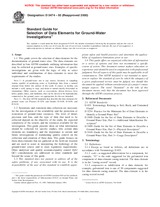Potřebujeme váš souhlas k využití jednotlivých dat, aby se vám mimo jiné mohly ukazovat informace týkající se vašich zájmů. Souhlas udělíte kliknutím na tlačítko „OK“.
ASTM D5474-93(2000)
Standard Guide for Selection of Data Elements for Ground-Water Investigations
Automaticky přeložený název:
Standardní Příručka pro výběr datových prvků pro podzemní vody Investigations
NORMA vydána dne 1.1.2000
Informace o normě:
Označení normy: ASTM D5474-93(2000)
Poznámka: NEPLATNÁ
Datum vydání normy: 1.1.2000
Kód zboží: NS-31367
Počet stran: 12
Přibližná hmotnost: 36 g (0.08 liber)
Země: Americká technická norma
Kategorie: Technické normy ASTM
Anotace textu normy ASTM D5474-93(2000) :
Keywords:
contamination assessment, data base, data elements, documentation, ground water, monitoring network, record, resource appraisal, site characterization, underground storage tank, waste disposal facility, ICS Number Code 07.060 (Geology. Meteorology. Hydrology), 13.060.10 (Water of natural resources)
Doplňující informace
| 1. Scope | ||||||||||
|
1.1 This guide covers the selection of data elements for the documentation of ground-water sites. The data elements are described in four ASTM standards outlining information that may be collected at ground-water sites. Examples of specific investigations are given with the logic of why to select individual and combinations of data elements to meet the requirements of the studies. Note 1--A ground-water site is any source, location, or sampling station capable of producing water or hydrologic data from a natural stratum from below the surface of the earth. A source or facility can include a well, spring or seep, and drain or tunnel (nearly horizontal in orientation). Other sources, such as excavations, driven devices, bore holes, ponds, lakes, and sinkholes, that can be shown to be hydraulically connected to the ground water, are appropriate for the use intended. Note 2--The four ASTM standards that describe the data elements for ground water are Practice D5254 and Guides D5408, D5409, and D5410. 1.2 Systematic and consistent data collection are necessary for the investigation of the availability and the protection or restoration of ground-water resources. The level of detail, precision and bias, and the type of data that need to be collected depend on the objective of the study, the expected complexity of the system, and the resources available for the investigation. This guide presents ideas on what information should be collected for specific studies, why certain data elements are mandatory, and the importance to current and future investigations of maintaining quality control on the collection and retention of these data. This guide focuses on those data elements that are gathered at the field-site location and are used to assist in interpreting the hydrology of the ground-water source and to meet regulatory requirements. Other analytical and quality assurance/quality control (QA/QC) considerations are addressed in other standards and beyond the scope of this guide. 1.3 This standard does not purport to address all of the safety problems, if any, associated with its use. It is the responsibility of the user of this standard to establish appropriate safety and health practices and determine the applicability of regulatory limitations prior to use. 1.4 This guide offers an organized collection of information or a series of options and does not recommend a specific course of action. This document cannot replace education or experience and should be used in conjunction with professional judgment. Not all aspects of this guide may be applicable in all circumstances. This ASTM standard is not intended to represent or replace the standard of care by which the adequacy of a given professional service must be judged, nor should this document be applied without consideration of a project's many unique aspects. The word "Standard" in the title of this document means only that the document has been approved through the ASTM consensus process. |
||||||||||
| 2. Referenced Documents | ||||||||||
|




 Cookies
Cookies
